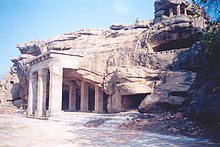The region of Kalinga is remembered for the battle that changed Emperor Ashoka’s life. The battle of Kalinga brought a lot of suffering and damage to the people of Kalinga. But the story of Kalinga and its magnificent past didn’t end here. They suffered from tough times and it was during this time that a hero rose who brought back the lost prestige of Kalinga.

The man who did this is known as Maharaja Kharavela the king of Kalinga who not only defeated Magadha but also established his hegemony over a vast region.
The powerful Mauryas subjugated the region of Kalinga and probably divided it into two parts for administrative purposes. One headquarter was at Tosali (near Bhubaneswar) and the other was at Samapa near Jaugada.
Content
Rise of Maharaja Kharavela: Background & Early History
The primary source that provides ample information about King Kharavela is the famous Hathigumpha inscription at Udayagiri hills. This inscription is written in Brahmi script and consists of a total of eleven lines.
Furthermore, historians had suggested that the inscription might have been written by a Jain monk.

Hatigumpha inscription tells us that the king belongs to the family of the Chedis (Mahamegahavahana). Also, it is believed that under the rule of the Mahamegahavahana family the region of Kalinga emerged as the most vital state of that time.
The actual date of King Kharavela’s reign is a little difficult to tell as there are not enough sources that provide accurate information about his tenure.
However certain historians have concluded that this monarch probably ruled during the second half of the first century BCE.
Maharaja Kharavela is the most iconic monarch of Kalinga. He is remembered for his magnificent work in restoring the lost pride of Kalinga, promoting of Jain religion, and building remarkable temples and Viharas. During his childhood days, Kharavela mastered the field of writing, accounting, administration, etc. It was during his 16th year when he was installed as Yuvaraja.
Note: He is believed to be the descendant of the ancient Chedi ruler Vasu (Vasu-Uparichara). It is believed that the founder of the Chedi clan was Maha-Meghavahana.

Later on, when he turned 24 he became the Maharaja of Kalinga. He was a staunch follower of Jainism and was known as Bhikshu-raja i.e. the monk king.
The most important thing about his personality was that this ruler was not a religious bigot. Modern historians had presented medieval Sultans as an ideal example of secularism and sidelined the real heroes of Indian history.
The personality of Maharaja Kharavela
King Kharavela was a very generous king who always made himself available to his people. He constantly worked for the betterment of his people by supporting them both financially and economically.
There is a story that tells us that King Kharavela built numerous buildings, gates, walls, gardens, and houses when the city was destroyed by a terrible cyclone.
Apart from all this, the king of Kalinga was also a great lover of music and even arranged constantly music and dance performances.
He also enlarged an irrigation canal which is believed to be built during the reign of the Nandas. He built a magnificent palace called the Mahavijaya-Prasada and a monastery at a place called Pabhara.
Kharavela Military Campaigns: Resurgence of Kalinga
The most important period of Maharaja Kharavela’s reign was his lethal military campaigns which established his hegemony and probably took Kalinga to the greatest territorial extent.
After his accession, he launched a Digvijayin campaign. He adopted the title of Kalingadhipathi/Kalingachakravartin which is enough to believe that he established his supremacy over a vast region.
It was during his second year as a king when the Kalinga army started to expand their kingdom. King Kharavela sent his army toward the western front of his empire. It is believed that the Kalinga army reached as far as river Krishna where they attacked the city of Rishika-Nagara.
During this time the early Satavahanas ruled the western region of the sub-continent and during the western expedition of King Kharavela Satakarni I was the ruler of Satavahanas.
Note: However there is no evidence that tells us about the conflict between the two rulers during this time.
Next King Kharavela subjugated the capital city of a king named as Vidyadhara and defeated the Ratikas and Bhojakas of the Berar region.
The inscription further adds that during his eighth year Kharavela successfully attacked the city of Rajagriha. It is believed that this expedition generated so much fear that the later Indo-Greek (probably Demetrius) king fled away to Mathura.
In the eleventh year, he destroyed the city of Pithuda of the king of Masulipatnam in madras.
Next year he defeated the ruler of Magadha probably known as Bahasatimita. Kharavela in order to avenge the defeat of the Kalinga during the time of Nandas and Mauryas carried away much booty from the region of Anga and Magadha with Jain image (Jina).
Note: He also defeated the Pandya king of the far south region.
King Kharavela took Kalinga to its peak and made it a dominant powerhouse of ancient India. The history of ancient India is filled with stories of dauntless kings like Maharaja Kharavela but unfortunately, none of the so-called historians had mentioned these stories.
Donate to our Cause
If you support what we are doing and would like to contribute to help us grow and reach more Indians to teach them more about such forgotten historic Indian Heroes and stories, please consider donating any amount. It will help us grow

